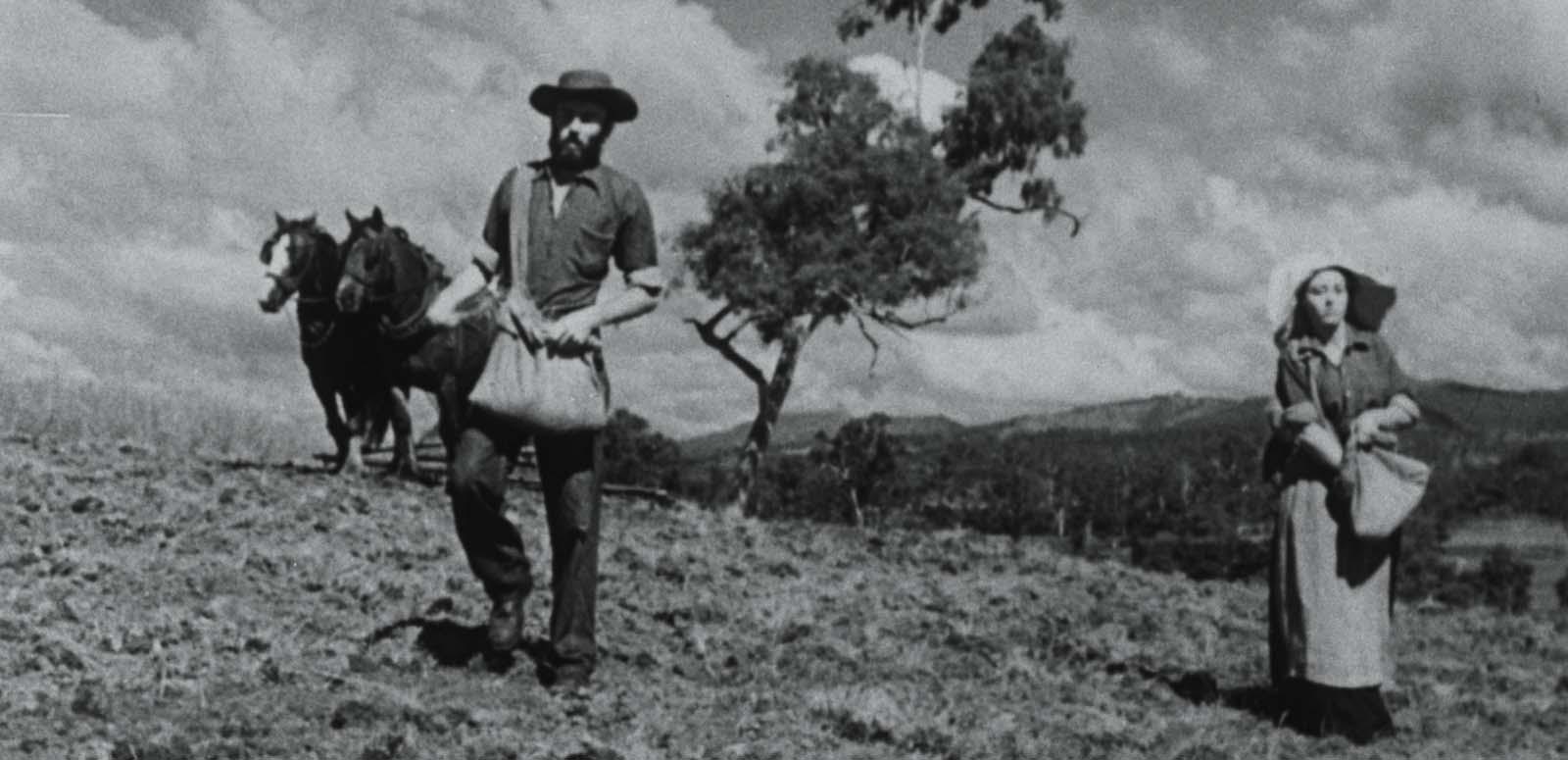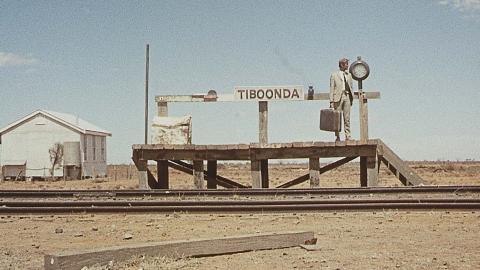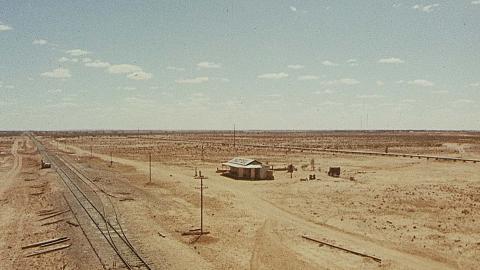

Outback on screen: Part 1
Graham Shirley traces the rich diversity of Australian cinematic representations and interpretations of the outback.
Introduction
The camera, as if fixed at the top of a windmill, pans 360 degrees around a limitless desert, interrupted only by a railway line and a tiny schoolhouse at the start of Wake in Fright (Ted Kotcheff, 1971). Two small girls in sunbonnets drag a billycart across isolated sand dunes in The Back of Beyond (John Heyer, 1954), not realising they have crossed their own tracks from hours before. An Aboriginal man explains the significance of rock art in Walya Ngamardiki: The Land My Mother (David Roberts, 1976); and a young Aboriginal fugitive from the law journeys along a series of outback roads while learning something of himself in Beneath Clouds (Ivan Sen, 2002). All of these films draw their considerable power from the Australian outback – on screen, as in life, a place for endless dreaming, living and working; of unnameable fears, of romance and getting lost.
Many of Australia’s creative interpretations of the outback over the last two centuries have reflected a mostly immigrant people’s interpretation of a landscape very different to the lands which they or their forbears came from. But like artists, poets and novelists, Australian filmmakers from the beginning have used the outback to define a sense of belonging.

Covering 70 per cent of Australia, the outback is remote, arid and lightly populated. Most of the remaining continent has been defined as ‘the bush’, comprising the well-watered domesticated or semi-domesticated coastal fringes east and south of the Great Dividing Range flanking eastern Australia, moving west via Melbourne to Adelaide as well as incorporating the island of Tasmania. Today, when most of Australia’s almost 23 million people live in urban areas, the character of the outback survives as a major ingredient in the nation’s novels, poetry, paintings, feature and short films, TV drama and advertising.
In 1896 cinema made its first global appearance at a time of intense nationalism for Australian identity, especially as interpreted through literature and painting. Australian novelists, short story writers and ballad writers of the 1880s and 1890s used the bush and outback to define what it was to be Australian. The painters Tom Roberts, Frederick McCubbin and Arthur Streeton created their own myths about frontier and farm life. From the 1890s onward Australian cinema would perpetuate these myths, eventually questioning and extending them.
The first Australians
Prior to white settlement, Aboriginal people had occupied Australia for at least 50,000 years – not a single Aboriginal nation but a gathering of several hundred communities or tribes, each with its own language, set of beliefs and territory on which many lived a nomadic and spiritual existence that recognised a community’s unique relationship with the land. Whites occupied much of that land after European settlement in 1788, dispossessing most tribes except those living a very remote existence.
Aboriginal people were first officially recognised as Australian citizens in 1967, one year after the Northern Territory Gurindji tribe launched the first Indigenous bid to obtain title to traditional land. They were among the earliest Australians filmed in the 1890s. In 1898 Cambridge University anthropologist Alfred Cord Haddon filmed Torres Strait Islanders and mainland Aborigines, making this the world’s first film of an anthropological field trip (see Torres Strait Islanders, 1898). In 1901 and 1912 Professor Walter Baldwin Spencer filmed the lifestyles and spiritual activities of the tribes of Central and Northern Australia.
Aborigines on screen in early filmmaking were often exploited subjects rather than people who had any say in how they were filmed and who would see the results. With rare exceptions, it was not until the 1960s and ’70s that documentary filmmakers sought to include the perspective of Aboriginal people. David Roberts in 1976 made the documentary Walya Ngamardiki: The Land My Mother, featuring Arnhem Land Aboriginal people talking about traditional attachment to their land and their attitudes to the uranium mining that could change it irretrievably. Oliver Howes’s documentary On Sacred Ground (1981) looks at the dispossession and loss of identity that provides a background to the late 1970s Noonkanbah land rights confrontation between traditional Aboriginal owners and miners in the Kimberley region of Western Australia.

Over time, Aboriginal people gained opportunities to speak for themselves about their relationship to and ownership of land, a number of whose landforms had sacred associations. More recently a new generation of Aboriginal filmmakers, producing for a variety of screen media including television, have been telling stories of Aboriginal history, myths, legends and connections with the land. Notable titles include My Survival as an Aboriginal (Essie Coffey, 1978), Willigan’s Fitzroy (Warwick Thornton, 2000), Narbalek (Beck Cole, 2000), Queen of Hearts (Danielle Maclean, 2003), Mparntwe Sacred Sites (Danielle Maclean, 2004), Plains Empty (Beck Cole, 2005), and the seven-part historical series First Australians (Rachel Perkins, 2008).
Taming the landscape
Australia’s much earlier makers of outback films had stressed the need to tame what Europeans saw as a wild and alien landscape, to fill it with Anglo-Irish farmers who would pack it with herds of sheep and endless fields of wheat. The Squatter’s Daughter (Ken G Hall, 1933) begins with a celebratory montage of thousands of sheep swarming across the Australian landscape as if to dominate and claim it forever. The Pioneers (versions of 1916 and 1925) and Charles Chauvel’s Heritage (1935) and Sons of Matthew (1949, pictured at top) stretch depictions of land-taming across several generations.
Aboriginal people, when they appeared in pre-1950 pioneering films, were usually depicted as attackers rather than defenders of their land. This changed with the Ealing Studios film Bitter Springs (Ralph Smart, 1950), a compassionate look at Aboriginal dispossession. The theme was to continue in Australian narrative films and documentaries, with Rachel Perkins’s short feature One Night the Moon (2001) looking not only at displacement but the need for reconciliation between black traditional owners and white settlers.
Screen portrayals of the white men and women who worked on outback land have inevitably ranged from a straightforward rendering of the work of pioneers and cattle drovers through to films that have looked at outback characters with a more analytical eye. At the height of the 1930s economic depression, the main enemies of the farming family in On Our Selection (Ken G Hall, 1932) are drought and a creditor from the city. In The Overlanders (Harry Watt, 1946) the adversary is a never-seen Second World War enemy, the Japanese, who might or might not launch an all-out invasion of Australia after periodically bombing Darwin.
In both cases the hero is an Australian archetype. In Selection it is the stout and bearded family patriarch Dad Rudd (Bert Bailey), a first-generation pioneer, a bit of a buffoon who nevertheless represented the idealised Australia of the 1880s and ’90s. The younger hero of The Overlanders (1946), skinny and clean-shaven, is stockman Dan McAlpine (Chips Rafferty), a modern pragmatist who might have had no time for Dad Rudd’s wistful yarn-spinning.

Humour has played a pivotal role among Australian screen outback characters. Before the Second World War, Australian stage and screen comedy was dominated by the bush-bred Dad and Dave characters and their generic relatives the Hayseeds. In the silent era Raymond Longford directed two Dad and Dave films and after the coming of sound Ken G Hall was to make four of them.
Humour continued to play a role in outback films as diverse as The Overlanders (1946), Bitter Springs (1950), Three in One (Cecil Holmes, 1957), Wake in Fright (1971) and Sunday Too Far Away (1975). But it was the comedy Crocodile Dundee (Peter Faiman, 1986) that became Australia’s most commercially successful film ever. It appealed to audiences by showcasing Northern Territory locations while establishing Dundee as a warm and likeable outback character, as film critic Paul Byrnes has observed, ‘self-made man, tough guy, bush philosopher, romantic lead, old-fashioned knight, defender of women, tamer of wild animals, and wandering free spirit’.
The National Film and Sound Archive of Australia acknowledges Australia’s Aboriginal and Torres Strait Islander peoples as the Traditional Custodians of the land on which we work and live and gives respect to their Elders both past and present.


